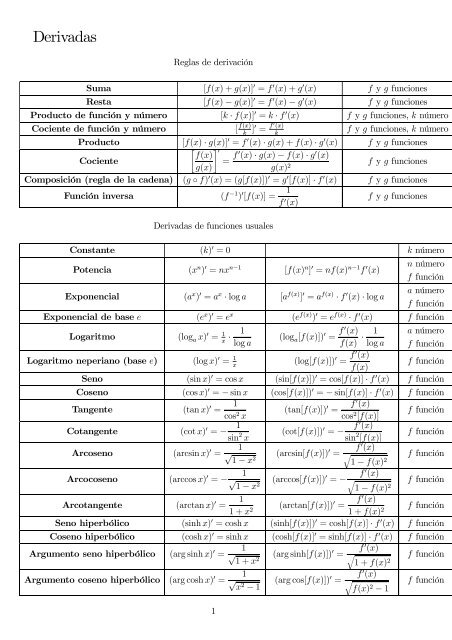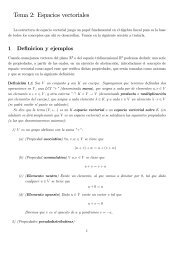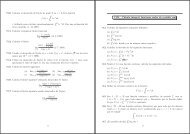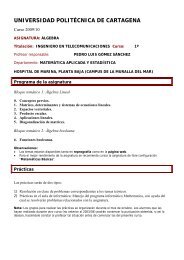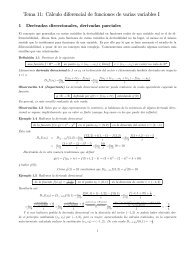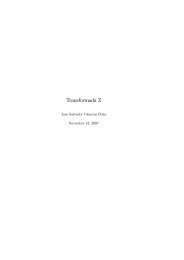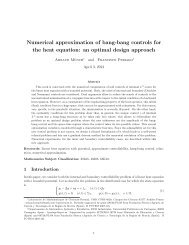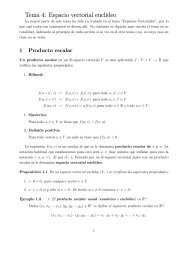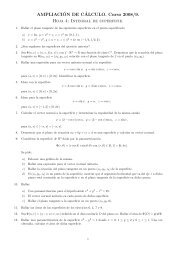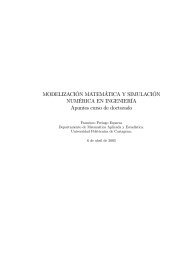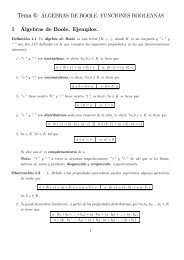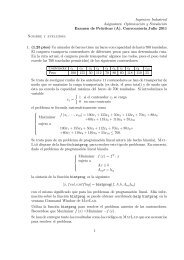Tabla de derivadas
Tabla de derivadas
Tabla de derivadas
You also want an ePaper? Increase the reach of your titles
YUMPU automatically turns print PDFs into web optimized ePapers that Google loves.
Derivadas<br />
Reglas <strong>de</strong> <strong>de</strong>rivación<br />
Suma [f(x)+g(x)] 0 = f 0 (x)+g 0 (x) f y g funciones<br />
Resta [f(x) − g(x)] 0 = f 0 (x) − g 0 (x) f y g funciones<br />
Producto <strong>de</strong> función y número [k · f(x)] 0 = k · f 0 (x) f y g funciones, k número<br />
Cociente <strong>de</strong> función y número [ f(x)<br />
k ]0 = f 0 (x)<br />
k<br />
f y g funciones, k número<br />
Producto [f(x) · g(x)] 0 = f 0 (x) · g(x)+f(x) · g0 Cociente<br />
(x)<br />
" # 0<br />
f(x)<br />
=<br />
g(x)<br />
f y g funciones<br />
f 0 (x) · g(x) − f(x) · g0 (x)<br />
g(x) 2<br />
f y g funciones<br />
Composición (regla <strong>de</strong> la ca<strong>de</strong>na) (g ◦ f) 0 (x) =(g[f(x)]) 0 = g0 [f(x)] · f 0 (x) f y g funciones<br />
Función inversa (f −1 ) 0 [f(x)] = 1<br />
f 0 (x)<br />
Derivadas <strong>de</strong> funciones usuales<br />
f y g funciones<br />
Constante (k) 0 =0 k número<br />
Potencia (x n ) 0 = nx n−1 [f(x) n ] 0 = nf(x) n−1 f 0 (x)<br />
Exponencial (a x ) 0 = a x · log a [a f(x) ] 0 = a f(x) · f 0 (x) · log a<br />
n número<br />
f función<br />
a número<br />
f función<br />
Exponencial <strong>de</strong> base e (e x ) 0 = e x (e f(x) ) 0 = e f(x) · f 0 (x) f función<br />
Logaritmo (log a x) 0 = 1<br />
x ·<br />
Logaritmo neperiano (base e) (log x) 0 = 1<br />
x<br />
1<br />
log a<br />
(loga[f(x)]) 0 = f 0 (x)<br />
f(x) ·<br />
1<br />
log a<br />
(log[f(x)]) 0 = f 0 (x)<br />
a número<br />
f función<br />
f(x)<br />
f función<br />
Seno (sin x) 0 =cosx (sin[f(x)]) 0 =cos[f(x)] · f 0 (x) f función<br />
Coseno (cos x) 0 = − sin x (cos[f(x)]) 0 = − sin[f(x)] · f 0 (x) f función<br />
Tangente (tan x) 0 = 1<br />
cos 2 x<br />
Cotangente (cot x) 0 = − 1<br />
sin2 x<br />
Arcoseno (arcsin x) 0 =<br />
1<br />
√<br />
1 − x2 Arcocoseno (arccos x) 0 1<br />
= −√<br />
1 − x2 (tan[f(x)]) 0 = f 0 (x)<br />
cos 2 [f(x)]<br />
(cot[f(x)]) 0 = − f 0 (x)<br />
sin2 [f(x)]<br />
(arcsin[f(x)]) 0 f<br />
=<br />
0 (x)<br />
q<br />
1 − f(x) 2<br />
(arccos[f(x)]) 0 = − f 0 (x)<br />
q<br />
1 − f(x) 2<br />
f función<br />
f función<br />
f función<br />
f función<br />
Arcotangente (arctan x) 0 = 1<br />
1+x2 (arctan[f(x)]) 0 = f 0 (x)<br />
1+f(x) 2 f función<br />
Seno hiperbólico (sinh x) 0 =coshx (sinh[f(x)]) 0 =cosh[f(x)] · f 0 (x) f función<br />
Coseno hiperbólico (cosh x) 0 =sinhx (cosh[f(x)] 0 =sinh[f(x)] · f 0 (x) f función<br />
Argumentosenohiperbólico (arg sinh x) 0 =<br />
1<br />
√<br />
1+x2 (arg sinh[f(x)]) 0 f<br />
=<br />
0 (x)<br />
q<br />
1+f(x) 2<br />
f función<br />
Argumento coseno hiperbólico (arg cosh x) 0 1<br />
= √<br />
x2 − 1<br />
(arg cos[f(x)]) 0 f<br />
=<br />
0 (x)<br />
q<br />
f(x) 2 − 1<br />
f función<br />
1
Observaciones:<br />
1. Se <strong>de</strong>duce <strong>de</strong> las dos primeras reglas <strong>de</strong> <strong>de</strong>rivación <strong>de</strong>ducimos la <strong>de</strong>rivada <strong>de</strong> los polinomios:<br />
(a0 + a1x + a2x 2 + a3x 3 + ... + anx n ) 0 = a1 +2a2x +3a3x 2 + ... + nanx n−1<br />
2. En las reglas <strong>de</strong> <strong>de</strong>rivación <strong>de</strong> la exponencial y el logaritmo se supone que la base a satisface<br />
0


